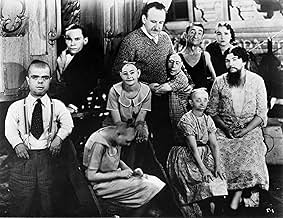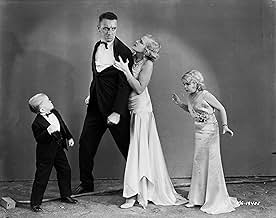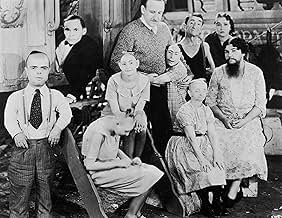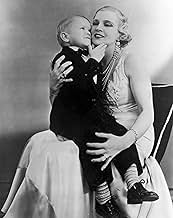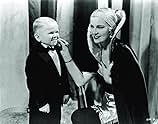IMDb RATING
7.8/10
53K
YOUR RATING
A circus' beautiful trapeze artist Cleopatra agrees to marry Hans the leader of side-show performers, but Hans' deformed friends discover that she is only marrying him for his inheritance. S... Read allA circus' beautiful trapeze artist Cleopatra agrees to marry Hans the leader of side-show performers, but Hans' deformed friends discover that she is only marrying him for his inheritance. So they seek revenge.A circus' beautiful trapeze artist Cleopatra agrees to marry Hans the leader of side-show performers, but Hans' deformed friends discover that she is only marrying him for his inheritance. So they seek revenge.
- Awards
- 2 wins & 1 nomination total
Roscoe Ates
- Roscoe
- (as Rosco Ates)
Prince Randian
- The Living Torso
- (as Rardion)
Featured reviews
"Freaks" is one of the most controversial horror films from the 30's,mainly because director Tod Browning hired as the actors real sideshow freaks.It does have a rather unsettling effect,but I think that really does work for the film.Browning builds up a great amount of suspense with the good use of locations,story and lots of atmosphere.The ending,where we see freaks crawling in the mud,is pretty creepy.Anyway check this one out-it's worth watching.
The subject of human disability is still a taboo subject in Cinema, even over 70 years since this film's release.
It's difficult to imagine what impact this film would have had in the 1930's, but as it still has the ability to shock ( through the images of bodily deformity ) I can understand why many shunned and disowned this work, and why it totally ruined Todd Browning's film career.
The basic premise - that beauty is more than skin deep - can appear to be wielded with a sledgehammer, but perhaps the contemporary audience needed to be hit harder in order to make them understand the point.
The film is short ( due to enforced cuts ), and at times can move rather slowly and can appear rather 'stagey' which is a trait of many films from the 20's / 30's.
But don't let that put you off. The plot is simple, but it's the telling of the story rather than the story itself that is important. And you really do need to remind yourself that these are real people - not actors - and this was the live they led.
I rate it 9 outa 10 because they really don't make them like this any more.
It's difficult to imagine what impact this film would have had in the 1930's, but as it still has the ability to shock ( through the images of bodily deformity ) I can understand why many shunned and disowned this work, and why it totally ruined Todd Browning's film career.
The basic premise - that beauty is more than skin deep - can appear to be wielded with a sledgehammer, but perhaps the contemporary audience needed to be hit harder in order to make them understand the point.
The film is short ( due to enforced cuts ), and at times can move rather slowly and can appear rather 'stagey' which is a trait of many films from the 20's / 30's.
But don't let that put you off. The plot is simple, but it's the telling of the story rather than the story itself that is important. And you really do need to remind yourself that these are real people - not actors - and this was the live they led.
I rate it 9 outa 10 because they really don't make them like this any more.
Don't let people convince you that "Freaks" is a horror movie, because it isn't. It's actually a quite sad and sympathetic look at the way abnormalities were treated in the early part of the 20th century, and has direct parallels to the obsession with physical perfection causing eating disorders today. Tod Browning of course asks us to consider who are the bigger freaks: those with deformed bodies or those with deformed souls? The two "normal" people who are out to cheat and steal are monstrous, whereas the freaks are quite likable and charming. The ending is disturbing to be sure, but it's hard to condemn the freaks for acts that seem largely justified.
Is it a coincidence that in several shots showing Cleopatra reclining on a sofa, she appears to be deformed herself (in one shot it looks as if she has no legs). Has anybody else noticed this? "Freaks" was obviously way ahead of its time. There's a very interesting documentary on the DVD about its reception in 1932; it bombed and pretty much ruined Browning's career. Thank God that the general public is not allowed to be the final arbiter of a film's value. Think how many priceless films we would have lost by now if that were the case.
Grade: A
Is it a coincidence that in several shots showing Cleopatra reclining on a sofa, she appears to be deformed herself (in one shot it looks as if she has no legs). Has anybody else noticed this? "Freaks" was obviously way ahead of its time. There's a very interesting documentary on the DVD about its reception in 1932; it bombed and pretty much ruined Browning's career. Thank God that the general public is not allowed to be the final arbiter of a film's value. Think how many priceless films we would have lost by now if that were the case.
Grade: A
A forest glade somewhere in Europe. A warm, sunny day with children playing on the grass. But the camera moves closer and reveals that something is terribly wrong. For these are not children, but tragically misshapen human beings. Pinheads. Dwarfs. A young man with only half a body. A man without arms or legs. These are the Freaks.
In 1932, director Tod Browning, fresh from his success with DRACULA, was instructed by Irving Thalberg to top FRANKENSTEIN. He succeeded. The resulting film was considered so ghastly that it was banned in Britain for 30 years. It is the strangest film MGM ever released.
Browning wanted to tell a tale of love, greed & revenge set in a circus, most particularly in the sideshow of human anomalies. He scoured Europe & America for the perfect cast. He got them: Violet & Daisy Hilton, the celebrated Siamese twins; dwarf brother & sister Harry & Daisy Earles; Johnny Eck the Half Boy (a good actor, he will remain in your mind a long time); the tragic Josephine Joseph, a hermaphrodite; as well as a human skeleton, armless girls and the female pinheads, among others.
While the plot is exploitive & the title tasteless, these people show us glimpses of their hearts, some of the agony of their condition and make us wonder, `What if I'd been born as one of them?'
The rest of the cast is made up of MGM stock players Leila Hyams, Wallace Ford, Edward Brophy, Olga Baclanova and the screen's champion stutterer Roscoe Ates.
The plot is simple. A beautiful trapeze artist marries a dwarf for his money, then plots his murder with her lover, the circus strong man. The subsequent action is both horrifying & strangely satisfying. Various scenes - the Freaks' Banquet, the chase through the storm - are among the most bizarre ever filmed. You won't soon forget the time you spend with the FREAKS.
In 1932, director Tod Browning, fresh from his success with DRACULA, was instructed by Irving Thalberg to top FRANKENSTEIN. He succeeded. The resulting film was considered so ghastly that it was banned in Britain for 30 years. It is the strangest film MGM ever released.
Browning wanted to tell a tale of love, greed & revenge set in a circus, most particularly in the sideshow of human anomalies. He scoured Europe & America for the perfect cast. He got them: Violet & Daisy Hilton, the celebrated Siamese twins; dwarf brother & sister Harry & Daisy Earles; Johnny Eck the Half Boy (a good actor, he will remain in your mind a long time); the tragic Josephine Joseph, a hermaphrodite; as well as a human skeleton, armless girls and the female pinheads, among others.
While the plot is exploitive & the title tasteless, these people show us glimpses of their hearts, some of the agony of their condition and make us wonder, `What if I'd been born as one of them?'
The rest of the cast is made up of MGM stock players Leila Hyams, Wallace Ford, Edward Brophy, Olga Baclanova and the screen's champion stutterer Roscoe Ates.
The plot is simple. A beautiful trapeze artist marries a dwarf for his money, then plots his murder with her lover, the circus strong man. The subsequent action is both horrifying & strangely satisfying. Various scenes - the Freaks' Banquet, the chase through the storm - are among the most bizarre ever filmed. You won't soon forget the time you spend with the FREAKS.
Banned in most countries for over three decades, this is one of the most bizarre and fascinating films Hollywood ever produced. Basically a soap-opera set in a side-show, it is a look into the lives of a group of sideshow performers in a traveling circus.
In the beginning of the film, we meet Cleopatra (Baclanova), a beautiful but avaricious trapeze artist who seduces and marries midget circus owner Hans (Earles) to get at his money. At the wedding reception, the close-knit society of freaks welcomes her into the family as "one of us, one of us." Cleopatra is disgusted however by this very thought and tells them she will never be grotesque, while her secret lover, Hercules the strongman, howls with laughter. She humiliates her smitten husband by openly kissing Hercules. After they find out they tried to poison Hans, the group comes up with an idea to take revenge at the beautiful trapeze artist and her strongman lover.
Tod Browning (DRACULA, THE UNHOLY THREE) put his career on the line with the making of this film. MGM, trying to compete with Universal, and cash in on the new appetite for horror films in the early thirties, never knew what hit them with this film. It caused quite a stir and such an amount of negative publicity they decided to virtually disown it and until the '60s it remained practically unseen. The fact that infamous bad film maker Dwain Esper (REEFER MADNESS, MANIAC, see my earlier review), showed the film in road shows and burlesque houses, only enhanced the film's notorious cult reputation.
Even today many scour away from seeing this film because of its supposed voyeurism. It might be seen as a very disturbing and ugly film, but at the same time a beautiful and ultimately a moving account of the shortcomings and prejudice of mankind. Most people didn't get it and many thought of it as a new low in Hollywood depravity and were horrified with the film. In truth it's a very warm and humane look at how physically deformed people manage on their own, and a fascinating insight in the world of side-show performers, a milieu Browning (a former "snake man" in the circus himself) was very familiar with. Not an outstanding film in terms of cinematic qualities, but because of the completely unique subject matter and the almost documentary like approach to the phenomenon of the side show, whilst using actual freaks, a term that didn't have the same connotation as today.
In 1994 the film was selected for the National Film Registry's archive of cinematic treasures. Rightfully so, not only because it's a unique piece of cinema but historically one the very few cinematic accounts left on attitudes towards disabled persons. Even today, the reluctance by most people to even admit this film's very existence, only exemplifies how many misunderstandings about people that are not "normal", still exist.
The recent DVD-release comes with the excellent documentary "Freaks: Sideshow Cinema."
Camera Obscura --- 9/10
In the beginning of the film, we meet Cleopatra (Baclanova), a beautiful but avaricious trapeze artist who seduces and marries midget circus owner Hans (Earles) to get at his money. At the wedding reception, the close-knit society of freaks welcomes her into the family as "one of us, one of us." Cleopatra is disgusted however by this very thought and tells them she will never be grotesque, while her secret lover, Hercules the strongman, howls with laughter. She humiliates her smitten husband by openly kissing Hercules. After they find out they tried to poison Hans, the group comes up with an idea to take revenge at the beautiful trapeze artist and her strongman lover.
Tod Browning (DRACULA, THE UNHOLY THREE) put his career on the line with the making of this film. MGM, trying to compete with Universal, and cash in on the new appetite for horror films in the early thirties, never knew what hit them with this film. It caused quite a stir and such an amount of negative publicity they decided to virtually disown it and until the '60s it remained practically unseen. The fact that infamous bad film maker Dwain Esper (REEFER MADNESS, MANIAC, see my earlier review), showed the film in road shows and burlesque houses, only enhanced the film's notorious cult reputation.
Even today many scour away from seeing this film because of its supposed voyeurism. It might be seen as a very disturbing and ugly film, but at the same time a beautiful and ultimately a moving account of the shortcomings and prejudice of mankind. Most people didn't get it and many thought of it as a new low in Hollywood depravity and were horrified with the film. In truth it's a very warm and humane look at how physically deformed people manage on their own, and a fascinating insight in the world of side-show performers, a milieu Browning (a former "snake man" in the circus himself) was very familiar with. Not an outstanding film in terms of cinematic qualities, but because of the completely unique subject matter and the almost documentary like approach to the phenomenon of the side show, whilst using actual freaks, a term that didn't have the same connotation as today.
In 1994 the film was selected for the National Film Registry's archive of cinematic treasures. Rightfully so, not only because it's a unique piece of cinema but historically one the very few cinematic accounts left on attitudes towards disabled persons. Even today, the reluctance by most people to even admit this film's very existence, only exemplifies how many misunderstandings about people that are not "normal", still exist.
The recent DVD-release comes with the excellent documentary "Freaks: Sideshow Cinema."
Camera Obscura --- 9/10
Did you know
- TriviaThe on-screen romance between Hans and Frieda was very subdued because the roles were being played by real life brother and sister Harry Earles and Daisy Earles.
- GoofsAt 43:40 when Cleo tosses the wine at Angeleno, she is standing in front of him, but the wine she throws comes from the far right side of the frame.
- Quotes
Freaks: We accept you, one of us! Gooble Gobble!
- Alternate versionsReissue prints included a two-and-a-half minute written prologue about historical interpretations and contemporary studies of "misshapen misfits." These same prints remove the MGM Lion (the studio having disowned the film for many years).
- ConnectionsEdited into Histoire(s) du cinéma: Le contrôle de l'univers (1999)
Details
- Release date
- Country of origin
- Languages
- Also known as
- Barnum
- Filming locations
- Production company
- See more company credits at IMDbPro
Box office
- Budget
- $310,607 (estimated)
- Gross worldwide
- $4,693
- Runtime
- 1h 4m(64 min)
- Color
- Aspect ratio
- 1.37 : 1
Contribute to this page
Suggest an edit or add missing content


